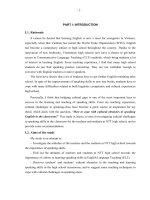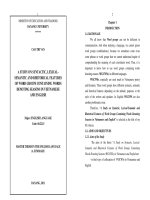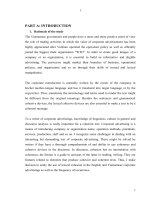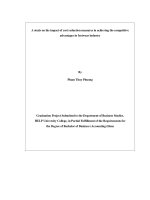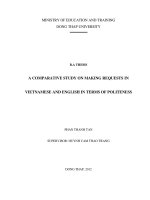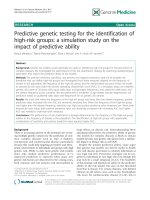study on hanlyu impact to vietnamese teenagers awareness of korea image
Bạn đang xem bản rút gọn của tài liệu. Xem và tải ngay bản đầy đủ của tài liệu tại đây (1.13 MB, 141 trang )
VIETNAM NATIONAL UNIVERSITY, HANOI
INSTITUTE OF VIETNAMESE STUDIES AND DEVELOPMENT SCIENCES
-----------------------------------------------------
KIM MIN JUNG
STUDY ON HANLYU IMPACT TO
VIETNAMESE TEENAGERS’ AWARENESS
OF KOREA IMAGE
MASTER THESIS
Major: Vietnamese Studies
Hanoi - 2012
TABLE OF CONTENTS
PRELUDE ...................................................................................................................... 10
1. Matter bring-up and study context ......................................................................... 10
2. Study purpose and constitution of the thesis .......................................................... 13
CHAPTER 1. OBSERVATION OF ARGUMENT ...................................................... 15
1.1 Observation of arguments on national image ...................................................... 15
1.1.1 Definition of national image concept ........................................................... 15
1.1.2 Major study standpoints on national image .................................................. 16
1.1.3 Receiving Korean mass culture and stages to form awareness/affection for
Korea image........................................................................................................... 21
1.2 Observation on argument on culture development .............................................. 23
1.2.1 Opening of cultivation theory ....................................................................... 23
1.2.2 Standpoints of studies on cultivation theory................................................. 25
1.2.2.1. Strong-effect standpoint ....................................................................... 25
1.2.2.2. Personality Standpoint .......................................................................... 27
1.2.2.3. Awareness standpoint ........................................................................... 30
1.3 OBSERVATION ON HANLYU IN VIETNAM ................................................ 31
1.3.1 Vietnamese media situation .......................................................................... 31
1.3.2 Forming and expansion of Hanlyu in Vietnam ............................................ 33
1
1.3.2.1 Television Soap Drama ......................................................................... 33
1.3.2.2 Cinema movie........................................................................................ 39
1.2.3.3 Popular music ........................................................................................ 40
1.3.3 Hanlyu impacts Vietnamese teenagers‟ taste ............................................... 42
CHAPTER 2. STUDY METHOD ................................................................................. 45
2.1 Study matter and study theory.............................................................................. 45
2.2 Definition of operation of study method .............................................................. 47
2.2.1 Investigation/survey ...................................................................................... 47
2.2.2 In-depth interview ......................................................................................... 48
2.3 Order of investigation .......................................................................................... 48
2.3.1 Collection of documents and study subjects ................................................. 48
2.3.1.1. Investigation/survey study.................................................................... 48
2.3.1.2. In-depth interview study....................................................................... 49
2.3.2 Demography statistics of interviewees ......................................................... 49
2.3.2.1. Investigation/survey study.................................................................... 49
2.3.2.2. In-depth interview study....................................................................... 49
2.4 Document analysis ............................................................................................... 50
CHAPTER 3. STUDY RESULT ................................................................................... 51
3.1 Investigation/survey result ................................................................................... 51
3.1.1 Verification of reliability .............................................................................. 51
2
3.1.2 Satisfaction extent of Hanlyu culture content and affection extent for Korea
image ..................................................................................................................... 52
3.1.2.1 Situation of receiving mass culture ....................................................... 52
3.1.2.2 Affection for mass culture by country................................................... 54
3.1.2.3 Situation of approaching Korean mass culture ..................................... 59
3.1.2.4 Hanlyu and Korea image ....................................................................... 82
3.2 Study result of in-depth interview study .............................................................. 91
3.2.1 Process of receiving Korean mass culture .................................................... 91
3.2.2 Korean mass culture...................................................................................... 95
3.2.3 Korean mass culture effect ......................................................................... 100
CONCLUSION ............................................................................................................ 105
1. Argument and summary of study result ............................................................... 105
2. Policy recommendation for Hallyu‟s continuous development in Vietnam ........ 112
REFERENCES ............................................................................................................. 119
APPENDIX .................................................................................................................. 128
3
INDEX OF TABLE
[Table 2.1] Gender and education of interviewees ....................................................... 49
[Table 2.2] Summary of in-depth interviewees ............................................................. 49
[Table 3.1] Time spent for watching TV ....................................................................... 53
[Table 3.2] Time spent for using Internet...................................................................... 53
[Table 3.3] Satisfaction level of cultural life ................................................................. 54
[Table 3.4] Problems of cultural life ............................................................................. 54
[Table 3.5] Frequency of watching television movie .................................................... 55
[Table 3.6] Transmittance means to watch television movie ........................................ 55
[Table 3.7] Affection for television soap drama by country ......................................... 56
[Table 3.8] Frequency of watching cinema movie ........................................................ 56
[Table 3.9] Transmittance means to watch cinema movie ............................................ 57
[Table 3.10] Affection for cinema movie by country ................................................... 57
[Table 3.11] Frequency of listening to popular music .................................................. 58
[Table 3.12] Transmittance means to listen to popular music ...................................... 59
[Table 3.13] Affection for popular music by country ................................................... 59
[Table 3.14] Interest extent in Korean mass culture ..................................................... 60
[Table 3.15] Satisfaction extent of Korean TV movie (General standard) ................... 60
[Table 3.16] Most impressive Korean TV movie ......................................................... 61
[Table 3.17] Best constituted elements of Korean TV movie ....................................... 61
4
[Table 3.18-1] Comparsion between Korean and Vietnamese TV movies (Theme/topic)
.................................................................................................................................... 61
[Table 3.18-2] Comparsion between Korean and Vietnamese TV movies (content
flow/pace) .................................................................................................................. 62
[Table 3.18-3] Comparsion between Korean and Vietnamese TV movies (dubbing) .. 62
[Table 3.18-4] Comparsion between Korean and Vietnamese TV movies (OST)) ...... 62
[Table 3.18-5] Comparsion between Korean and Vietnamese TV movies
(looks/fashion of actors) ............................................................................................ 62
[Table 3.18-6] Comparsion between Korean and Vietnamese TV movies (acting) ..... 63
[Table 3.18-7] Comparsion between Korean and Vietnamese TV movies
(background/atmosphere) .......................................................................................... 63
[Table 3.18-8] Comparsion between Korean and Vietnamese TV movies (Shooting
technique/Special effect)............................................................................................ 63
[Table 3.18-9] Comparsion between Korean and Vietnamese TV movies (General
standard)..................................................................................................................... 63
[Table 3.19] Problems in using Korean TV movie ....................................................... 64
[Table 3.20] Satisfaction extent of Korean cinema movie (General standard .............. 64
[Table 3.21] Most impressive Korean cinema movie ................................................... 65
[Table 3.22] Best constituted elements of Korean cinema movie................................. 65
[Table 3.23-1] Comparsion between Korean and Vietnamese cinema movies
(Theme/Topic) ........................................................................................................... 66
[Table 3.23-2] Comparsion between Korean and Vietnamese cinema movies (Content
flow/pace) .................................................................................................................. 66
5
[Table 3.23-3] Comparsion between Korean and Vietnamese cinema movies (Dubbing)
.................................................................................................................................... 66
[Table 3.23-4] Comparsion between Korean and Vietnamese cinema movies (OST) . 66
[Table 3.23-5] Comparsion between Korean and Vietnamese cinema movies
(Looks/Fashion of actors) .......................................................................................... 67
[Table 3.23-6] Comparsion between Korean and Vietnamese cinema movies (Acting)
.................................................................................................................................... 67
[Table 3.23-7] Comparsion between Korean and Vietnamese cinema movies
(Background/Atmosphere)......................................................................................... 67
[Table 3.23-8] Comparsion between Korean and Vietnamese cinema movies (Shooting
technique/Special effect)............................................................................................ 67
[Table 3.23-9] Comparsion between Korean and Vietnamese cinema movies (Director)
.................................................................................................................................... 68
[Table 3.23-10] Comparsion between Korean and Vietnamese cinema movies (General
standard)..................................................................................................................... 68
[Table 24] Problems in using Korean cinema movie .................................................... 68
[Table 3.25] Satisfaction extent of Korean popular music (General standard) ............. 69
[Table 3.26] Reasons for loving Korean popular music ............................................... 69
[Table 3.27] Favorite Korean singers ............................................................................ 70
[Table 3.28] Best constituted elements of Korean popular music ................................ 70
[Table 3.29-1] Comparsion between Korean and Vietnamese popular music (looks) . 71
[Table 3.29-2] Comparsion between Korean and Vietnamese popular music (singing
capability) .................................................................................................................. 71
6
[Table 3.29-3] Comparsion between Korean and Vietnamese popular music
(melody/rthym) .......................................................................................................... 71
[Table 3.29-4] Comparsion between Korean and Vietnamese popular music
(genre/style) ............................................................................................................... 71
[Table 3.29-5] Comparsion between Korean and Vietnamese popular music (lyric)... 72
[Table 3.29-6] Comparsion between Korean and Vietnamese popular music (dance). 72
[Table 3.29-7] Comparsion between Korean and Vietnamese popular music
(fashion/accessories) .................................................................................................. 72
[Table 3.29-8] Comparsion between Korean and Vietnamese popular music (music
video) ......................................................................................................................... 72
[Table 3.29-9] Comparsion between Korean and Vietnamese popular music (general
standard)..................................................................................................................... 73
[Table 3.30] Problems of Korean popular music .......................................................... 73
[Table 3.31] Vietnamese interest in TV movie/cinema movie ..................................... 74
[Table 3.32] Sympathy of comprehensive contens of TV movie/cinema movie .......... 74
[Table 3.33] Looks and acting/singing capability of famous actors/singers ................. 74
[Table 3.34] High standards for TV movie/cinema movie/video clip production
technique .................................................................................................................... 74
[Table 3.35] TV movie/Cinema movie helps viewers understand lives of many social
classes ........................................................................................................................ 75
[Table 3.36] Whole family can enjoy altogether ........................................................... 75
[Table 3.37] Contents of TV movie/cinema movie are interesting ............................... 75
7
[Table 3.38] Special theme/topic................................................................................... 75
[Table 3.39] Director/Producer of TV movie/cinema movie‟s capabilities are far better
.................................................................................................................................... 76
[Table 3.40] Competitiveness of TV movie/cinema movie is rather high .................... 76
[Table 3.41] General affection extent............................................................................ 76
[Table 3.42] Good acting............................................................................................... 76
[Table 3.43] Help to change moods .............................................................................. 77
[Table 3.44] No unreasonable points in content in general........................................... 77
[Table 3.45] Good content and message ....................................................................... 77
[Table 3.46] Emotional .................................................................................................. 77
[Table 3.47] Creative form ............................................................................................ 78
[Table 3.48] Overall organized ..................................................................................... 78
[Table 3.49] Beautiful picture or music ........................................................................ 78
[Table 3.50] Useful ........................................................................................................ 78
[Table 3.51] Exerting varied affection .......................................................................... 79
[Table 3.52] Good planning .......................................................................................... 79
[Table 3.53] Can enjoy freely........................................................................................ 79
[Table 3.54-1] Intention to using Korean mass culture contents afterward? (TV movie)
.................................................................................................................................... 80
[Table 3.54-2] Intention to using Korean mass culture contents afterward? (cinema
movie) ........................................................................................................................ 80
8
[Table 3.54-3] Intention to using Korean mass culture contents afterward? (popular
music)......................................................................................................................... 80
[Table 3.55] Awareness of Hanlyu................................................................................ 81
[Table 3.56] Awareness of counter-Hallyu (Protest Hallyu/Hate Hallyu) .................... 81
[Table 3.57-1] Korean mass culture contents and its connection with Korea image (the
investigated) ............................................................................................................... 82
[Table 3.57-2] Korean mass culture contents and its connection with Korea image
(people around) .......................................................................................................... 83
[Table 3.57-3] Korean mass culture contents and its connection with Korea image
(Vietnamese) .............................................................................................................. 83
[Table 3.62] Interest exent in Korean history ............................................................... 89
[Table 3.63] Interest extent in Korean politics .............................................................. 90
[Table 3.64] Interest extent in Korean society .............................................................. 91
9
PRELUDE
1. Matter bring-up and study context
In the past 15 years, Korean mass culture phenomenon centered by popular music
and television movies has spread out to not only Asian countries such as China, Taiwan,
Japan, Vietnam, Thai Lan, etc. but also to countries of North America, Europe, South
America and Middle East. Simultaneously, cultural products originating from Korean
family products such as travelling, food, fashion, etc. are also loved. The phenomenon
is named by the press as Hanlyu. Hanlyu helped to form and increase affection for
Korea image worldwide [50; 63; 3; 56; 85; 57]. Basically, the forming and
transforming a national image must be accumulated in a long period of time. However,
Hanlyu is an exception. It transformed Korea image positively within a very short
period. Accordingly, Hanlyu is significant to understand deeply impacts made to a
national image.
However, during the time, discussion about Hanlyu majorly based on popular media
and outcome of such discussion only specified that the pre-eminence of Korean culture
is cultural products with enormous economic benefits and accordingly, strengthening
Hallyu will increase and enlarge competitiveness [39]. After its success peak of “The
Winter‟s Sonate” and “Dae Jang Keum” in 2000, for a certain following period Hanlyu
did improve marginally. In that context, the Korean Government and enterprises
carried out studies on forecast and development of Hanlyu.
In the past 10 years, according to Son Seung Hye‟s [86] analysis of overall trend of
Hanlyu-related studies, 80% of these only mention policy recommendation to enlarge
Hanlyu in terms of tourism/economy/business, and half of them are based on foreign
user studies and observation from specific countries/regions. Further, all the studies
only focus on Japan and China. Scholars put forward various arguments, analysis and
10
criticism on Hallyu [47; 92; 93; 61; 38], however, after 2006, there have not been many
in-depth studies using factual verification method developed.
Korean, upon talking of Hanlyu in Asia, normally focus their interest on Hanlyu in
Japan and China (including Hong Kong and Taiwan) and consider those as
representatives of the whole Asia region. This is because of the Korean market value in
these two countries as well as the close connection of them with Korea in terms of
history and politics. The South East Asia is also mentioned in “Asia” conferences and
among the 10 countries in the region, Vietnam is the only one mentioned in all of the
conferences.
Vietnam and Korea, after establishment of diplomatic relationship in 1992, have
been maintaining, co-operating in promotion/expansion in various fields including
economy, politics, trade, culture, etc. Along with this fact, the important role of Korean
mass culture in reinforcing the two‟s relationship is undeniable. Korean television
movies have been broadcast continuously in Vietnam since 1997, attracted great
interest and broadcast in every televisions from central to local levels. Thanks to that,
Vietnamese‟s awareness of Korean cultural/economic goods has been materially
increased [13]. And, according to a survey of television movie viewers, the rate of
Vietnamese who are interested in Korean popular music, cosmetics, fashion, food,
goods, language or study has also grown up [12;10;7]. Particularly, in recent years, in
many localities of Vietnam, the number of Vietnamese women who want to marry
Korean men has surged, emphasizing the great effect of Korean movies. In accordance
with the source of the Korean Department of Statistics, in 2000, the number of
Vietnamese women marrying Korean men was only 77. However, the number was
11
5,822 in 2005 and 7,636 in 2011 (totally, there were 59,898 in 2011) 1. The main reason
behind the fact is increase of Vietnamese‟s awareness of Korea image and affection for
Korea/Korean people.
In South East Asia countries including Vietnam, there are not many studies on the
process of forming and enlarging Hanlyu except for a few such as “Study on the
process of receiving and enlarging Korean culture in South East Asia” of Lee Jin Soek
and colleagues [65] or “Assessment and comparison analysis of ảanlyu in East Asia”
of Sin Yoon Hwan [85]. These studies do not solely focus in Vietnam but also
analyze/summarize Hanlyu in East Asia countries. Therefore, they cannot provide indepth understanding on the effect of Hanlyu, Korean television movies in particular, in
Vietnam. The first study on the process of forming and enlarging of Hanlyu in Vietnam
is undertaken by Lee Han Woo [62]. However, given the study only refers to certain
journalists‟ analysis and interview of few Korean people living in Vietnam, its outcome
is only a preliminary introduction of Hanlyu in Vietnam. “Study on awareness of
Korean television movies in Vietnam” of Kim Young Chan [55] is the latest study on
Hanlyu effect to Vietnamese. The author used simultaneously various study methods
including questionnaire, interview and observation and more importantly, the study
specifies that positive awareness of Korean people/Korea is formed due to effect of
Korean television movies. Moreover, given most of the study‟s subjects are Korean
language student, outcome of the study could be popularized. Other studies in Vietnam
[12;1-;7] do not use the factual verification method but only assess Hanlyu in Vietnam
by visual affection.
In summary, up to now there are just a few studies specifying the on-going impact of
Hanlyu in Vietnam. Notwithstanding that, as Kim Young Chan said: “Ảiven the
1
Korea Department of Statistics ( />
12
consumption of Hanlyu through each intermediary, each consumer, each period, each
Asian country is different, it is essential that factual verification study should stick to
receivers and media society of each individual country to specify the overall impact of
Hanlyu in terms of industry, economy and culture. However, up to date most of people,
including scholars, have organized the idea on the basis of incorrect concept and
prejudice of majority at their own will, without any verification study or particular
base of ảanlyu in various Asian countries” [55]. Sin Yoon Hwan [85] states that
depending on the difference among economic standards of each East Asia country,
Hanlyu will have different status, measures and characteristics. Accordingly, in order
to understand in depth Hanlyu in Vietnam, the thesis author‟s view is that it is essential
to dig further on the social context of Vietnam in accordance with each Vietnamese
subject.
2. Study purpose and constitution of the thesis
As mentioned above, in context of lacking studies mentioning in depth effects of
Korean mass culture in Vietnam, this thesis will constitute the Vietnamese teenagers‟
awareness/affection for Korea by using factual verification method to understand in
depth effects of receiving Korean mass culture.
The argument of this study is based on the Cultivation Theory and National Image
and Interview/Survey method. Subjects of this study‟s survey/interview are teenagers
living in Hanoi to clarify the following points:
First, in context of Hanlyu being formed in a number of countries, finding out the
current situation of receiving Korean mass culture of Vietnamese teenagers;
Second, forming the awareness/affection for Korea image and clarifying effect of
Korean mass culture;
13
Third, finding out whether various phenomena considered as recently formed under
effect of Korean mass culture in Vietnam (i.e. increase of demand for trading Korean
products, increase of interest in learning Korean language and studying in Korea,
increase of number of women who want to marry Korean men, etc.) are really formed
under effect of Korean mass culture.
Apart from the above purposes, this study also aims to play a part in forming a
common culture community to dynamize the cooperation between Vietnam and Korea.
In light of the purposes, this study consists of 5 chapters with the following contents:
Prelude: Issue bring-up, study context, study purposes and constitution of thesis.
Chapter 1: Observation of Argument, including Section 1 – Observation of
arguments on national image; Section 2 – Observation of arguments on culture
development; Section 3 – Observation in relation to receiving Korean mass culture in
Vietnam. Provide essential basis/origins for the matter through Chapter 2.
Chapter 2: Discussion on study methods, including Section 1 – Study Matter and
Study Theory, Section 2 – Definition of variable reasons relating to each study matter
and theory, Section 3 – Order of Investigation, Section 4 – Document analysis
technique.
Chapter 3: Providing study results including Section 1 – Results of
Investigation/Survey, Section 2 – Results of interview.
Conclusion: Conclude the matter including Section 1 – Summary of study results
and arguments; Section 2 – Restrictions and recommendations.
14
CHAPTER 1. OBSERVATION OF ARGUMENT
1.1 Observation of arguments on national image
1.1.1 Definition of national image concept
Definition of national image concept should be viewed under two aspects. From the
view of international marketing, national image is “Ảeneral awareness of quality of
products manufactured in a specific country” [21]. Or “Consumers or Enterprises‟
opinion on image, reputation, quality on products of a specific nation” [71]. Roth and
Romeo [80] based on this to re-define national image as “Consumers‟ basic awareness
to form capacibility of discrimination of weaknesses, strengths of marketing and
production of a specific country corresponding to its products”. Accordingly, national
image is closely related to consumers‟ product trading and quality assessment [21].
On one hand, national image could be understood as “image of the country in a
general and overall way” [19]. In accordance with Jeong Kyung Won [37], national
image could be viewed from aspect of “macro/micro” and “visible/invisible” and is a
concept consisting of various elements such as image, tradition, accommodation,
unique products manufactured in such country or industrial product design, arts,
nationalism, history, etc. of the overwhelming thought, politics, economic structures,
social regime, other constituting elements of a country [37]. An Jong Seok defined
national image as “a group of individuals of impression, ideas and subjective beliefs”
[19].
Hall (1996)2 defined national image as “description of a person‟s awareness of a
country or its people, or that everyone believes on a general fact of a country or its
people”. In particular, Jeong Kyung Won stated that national image is not only a
Kang Hyung Ku∙Mun Ho Jin∙Yun Jung Won (2007)-Study in relation to mututal awareness of Korean cultural
product and Korea image: focusing on Korean and Chinese students 婚Marketting study恨,No. 76, re-cited from
9-28).
2
15
personal thought of a nation but also common “mindset” of the majority of people, and
national image can also be understood as “foreigners‟ prejudice or inherent opinion on
a specific nation” [37]. Or, national image is the overall image of various elements of
economy, politics, society, culture of the country, which people think as “a group of
elements” when imaging this country [33].
If we look at the above two trends of definition on national image, it can be seen that
later scholars often have broader scope compared with former ones (i.e. definition of
former scholars is included in that of the later ones).
In light of the later scholars‟ view, except for product image, national image also
includes images on its overall structure including economy, politics, history, culture,
traditions, etc. An Jong Soek further clarifies that national image is a concept of broad
scope consisting - besides economy, politics, culture - of its people‟s image also [19].
In short, although definitions may be slightly different, in overall, national image is
described by words with similar meaning such as “feeling”, “inherent opinion”,
“awareness”, “impression” or “idea”.
1.1.2 Major study standpoints on national image
Studies on national image have been expanded to many various fields such as “from
international marketing to advertising, speech, promotion over the past years since its
first appearance on 1965 in Schooler” [38]. Those could be divided into two major
trends:
The first trend is to study on effect of national image forming awareness and
foundation of elements relating to products of a country by independent variable
reasons contradicting to the national image. These studies are popular in international
marketing. Kim Bong Cheol∙Lee Byung Kwan∙Choi Yang Ho studied on how Chinese
college students‟ awareness of Korea image and advertisement makes effect on Korean
16
enterprises and products, showing the close relation between Korea Image and Korean
enterprises/products. In such a fiercely competitive market, when consumers
purchase/sell a certain product - besides its quality and price - the product‟s “sociality,
culture value and origin image” also greatly impact their decision [45] given that
consumers, before deciding to purchase or sell a product, have already pre-assessed the
product quality through their basic awareness of the corresponding national image, thus
forming affection for the product which in turn directly impacts their decision [43].
Therefore, national image is a very important concept in international marketing.
The second standpoint on national image is directly related to this thesis, which is
studying on various elements which might impact national image. According to Jung
Kyung Won [37], national image “is not a sudden production in the morning”; there
are elements influencing the process of forming it. Under this standpoint, though there
are many studies dealing with national image theme, if viewing from general
communication aspect, national image could be formed through four (4) trends
including direct experience [73], direct communications with people, communications
with products/services and communications with the media [74]3.
Direct experience includes cases of people travelling/visiting a country, experiencing
its values and simultaneously awaring it [73]. However, as this trend is limited by time
and cost, it is only applicable to a small number of people and therefore not the popular
way to form awareness of a country‟s image.
Direct communication with people, similarly, has the following meaning “an
individual forming awareness of a country and its people through her direct
Park Ki Soon (1996) – Korea image and overseas marketing of Korean enterprises: Focusing on precedence and
policy, Korean Association of public relation, marketing class (re-cited by Kang Hyung Ku∙Moon Hyu Jin∙Yoo
Jung Won in 2007)
3
17
communication with the people, organization, community of the country…” [74]. As
each individual transmits her self-experience to others through communication,
awareness of the national image might be broaden gradually through such individuals‟
communication [18]. However, communication among individuals, like the first trend,
also has lots of restrictions. It is normally not easy for individuals to communicate with
others from other countries everywhere and every time and therefore, this trend is also
not the popular trend to form a country‟s image.
The third trend is forming a country‟s image through its products/services (i.e. by
using its services or purchasing its household products or unique products). Given this
trend is more convenient than the aforementioned two and has a broader scope of
application, it could be considered one of the popular trends to form awareness of a
country‟s image. Where an individual cannot experience a country directly by way of
travelling/visiting, she can form awareness of its image via self-assessment of products
made by such country. However, a national image formed via products only shows its
economic aspect in a general and limited way due to not fully reflecting other aspects
such as society, culture or politics.
In light of the above, among the four trends, the trend of forming national image
through cultural products including media (especially cinema movies, music, television
movies, etc.) should be regarded as the most efficient and comprehensive as media can
simultaneously transmit image and sound and thus, will easily impact awareness of
receivers. Particularly, in today‟s context, information media has been rapidly
developing; people generally depend on media to receive information on a specific
country, and at the same time, have the trend to form awareness/affection for that
country [18]. With reference to the case of Korea recently, Hanlyu or an eruption of
Korean mass culture play a very important role in increasing affection for Korea/Korea
image. The word “Hanlyu” started to be widely used by Chinese media to imply the
18
great impact of Korean cultural products in the mid of 1999 and was used by Korean
media first in February 2000 – the time of H.O.T‟s live show in China [58]. Though
definition of Hanlyu of each individual might be slightly different, generally it could be
understood as the wave of Korean mass culture including television movies, movies,
music, food, games, etc. prevailing in the center of Asia [63]..
Sharing the same opinion, Ko Jung Min∙Lee An Jea∙Kang Sin Kyum defined Hanlyu
as “the phenomenon of extreme love for Korean mass culture”. The development
stages of Hanlyu are generally based on popularity of Korean mass culture to increase
interest to purchase a related cultural product, increase purchasing power of Korean
products and increase affection for Korea positively [58]. According to Ko Jung Min,
Hanlyu has brought Korea about many benefits, both direct and indirect. Under the
aspect of “direct export effect”, Hanlyu promotes Korean cultural industry by
exporting various cultural products such as movies, television, music, games,
entertainment, shows, etc. “Direct export effect” is evidenced by export increase of
normal products and Hanlyu-movie-related products including Korean cosmetics,
tourism, accessories, fashion, mobile phones. Further, Hanlyu – as the manufacturing
inspiration for normal/Hanlyu-related products, cultural industry development – also
has the “national economic pervasion effect”. Finally, Hanlyu archives an
immeasurable effect in promoting Korea image in diplomacy by increasing interest on
Korean food and Hangul [57].
In accordance with the statistical figures in 2005 of KOTRA, Hanlyu effect to China
significantly improved Korean image and affection for Korean in the country (increase
to 82.2% in 2005 while the same figure of 2004 is only 47.1% [68]. According to Lee
Won Yuong‟s study [68] on Hanlyu effect on goods trading power and Korea image,
the awareness of Korea of interviewees after Hanlyu has been comprehensively
strengthened compared to those before it.
19
Notwithstanding that, though Hanlyu creates positive effect on product assessment
and Korea image, it still could not significantly impact goods purchasing power. Per
Lee Jun Young [66]‟s study, after experiencing Korean cultural products, Chinese‟s
awareness and affection for Korea was positively improved and thanks to that, the
relation between Korea and China, attitude towards Korea and trends to use Korean
goods also grew up. In other words, Hanlyu not only influences awareness of Korea
image but also affection for Korea. Sharing the same opinion, studies of Jo Hye Yuong
[39], Kim Mi Joo [50] with subjects being people from Hong Kong, Taiwan, Thailand
also provide similar results (i.e. Hanlyu impacts to the interest of visiting Korea, Korea
image, Hanlyu cultural and tourism products of popular Korean music).
Similar to the above, the phenomenon of increasing affection for a country‟s image
through direct contact with its cultural products can be explained by Shanahan &
Morgan‟s argument [82]. Following which, in a norm culture with conceptional values,
a country‟s culture is expressed by its cultural products and, when consumed in another
country, such values will be transmitted to that consuming country. Hanlyu is a popular
precedence of the trend. Through consumption of Korean cultural products, people of
Asian countries such as Japan, China, Vietnam, Thailand, Taiwan, Singapore have
formed their awareness of Korea image/ affection for Korea carried in such products
[66].
In summary, along with the development of communication technique in the past
years, the importance of media is becoming more and more emphasized. In the context,
in order to form affection and awareness of a country‟s image, rather than trends such
as use of its products, communications with its people, direct communications with the
nation, the media-use trend appears to be more efficient. Pertaining to Korea‟s case, it
is undeniable that the spread-out of Hanlyu in media in recent years plays a significant
role in forming awareness/affection for Korea image. Under such trend, Vietnamese‟s
20
awareness of Korea image could be regarded as a positive result of Hanlyu.
1.1.3 Receiving Korean mass culture and stages to form awareness/affection for
Korea image
According to previous studies, watching foreign television movies could form
awareness/affection for the foreign country. Television movies satisfying viewers‟
demand are playing the role of a mean of sociality by transmitting belief and specific
values, etc. on reality to the viewers and have surpassed their original value of being an
entertainment mean. Accordingly, television movies could become a guidance to form
reality, create impacts to awareness and judgment of viewers on a specific subject [54].
Especially, since television movies are better in terms of approach, convenience and
popularity compared with cinema movies, and also depict more closely our ordinary
lives, they play a significant role in forming our awareness of the social picture [49].
Kim Jae Huy and Seo Jong Hee [49] specifies the difference between limited group
and experiencing group through study results on impacts of watching Japanese
television movies to Korean‟s inherent opinion on Japanese. Or, watching Japanese
television movies have changed Korean‟s unofficial awareness of Japanese social
standards. Accordingly, awareness of an individual on a country through direct visit or
communication with its people cannot be equally compared with that formed through
its media, especially television movies.
Furthermore, as the transmittance of a country image through television movies can
include various aspects such as media, history, culture, accommodation, politics,
economy, society, etc. and increasable, it has a broader and more general scope
compared to other trends [48]. Affection and interest on a country can also be formed
through affection for its television movies.
Pertaining to Korea‟ case, it is an undeniable fact that the role of Korean television
movies is vital in increasing awareness/affection for Korea image in the past 15 years.
21
According to a survey on foreign tourists in 2008, thanks to the broadcast of “Dae Jang
Keum”, interest and affection for Korean food have significantly gone up [50]. Kim Jae
Huy and Lee Hee Seong [48] said, watching Korean movies helped to increase
Japanese‟s interest and affection for Korea indirectly through their affection for Korean
television movies. Further, affection for Korean movies (formed through television
movies) could positively impact the assessment of Korean products. Lee In Koo and
Kim Jong Bae [63] identifies that Hanlyu satisfaction could create a positive influence
to Chinese and Japanese‟ acts of travelling to Korea and purchasing Korean products in
their study on Hanlyu phenomenon in Japan and China. Or, the more an individual is
keen on Korean television or cinema movies, the more she wants to purchase Korean
products and travel to Korea [63]. Particularly, in China, the affection for Korean
movies is not only limited in teenagers but also to middle-aged, who have become an
important social class to form Korea affection [60]. Not only in China and Japan, the
phenomenon also appears in many other countries. In other words, Korean cinema or
television movies, in the first place, have increased positive awareness of Korea image,
which in turn creates positive impact to their intention of travelling to Korea [52]. In
regard to the quantity of television movie viewers, certain studies state that the more
the movie time is, the more positive the viewers‟ awareness of Korea image and
travelling to Korea [36].
Through a number of similar studies, the receipt of Korea mass culture is considered
having created a positive impact to forming awareness and affection for Korea image.
Based on the foundation provided by the studies, Korean mass culture in Vietnam is
forecast to create the same affection to Vietnamese. However, as Kim Mi Joo [50] said
“Though ảanlyu or Korean mass culture of each Asian region has general
characteristics, in fact its role and level of impact are different depending on culture,
manners and customs of each nation. Most studies on Hanlyu up to now only focus on
22
subjects from Japan, China, Taiwan. However, in the above context, a profound study
on the actual effect of Korean mass culture in Vietnam is necessary.” Since every
Asian country has its particular socio-economic, culture, history, it is necessary to
understand the true meaning of Hanlyu in the context of each country itself [55].
Accordingly, this study will, through the factual verification method, find out how
the receipt of Korean mass culture impacts the forming of Vietnamese‟s
affection/awareness of Korea image. Therefore, this study will base on the culture
development argument.
1.2 Observation on argument on culture development
The phenomenon that watching television movies creates impact to forming
individual‟s awareness and affection for a specific country is explained by the
standpoint of culture development theory (i.e. cultivation theory).
1.2.1 Opening of cultivation theory
The first argument on the role of media in the process of receiving outside
information/knowledge of an individual was first brought up by Water Lippman
(1950)4. Following which, our awareness on social picture is constituted by “Pictures
in my head” and the picture is directly influenced by popular information. Therefore,
the popular information‟s depiction of social picture not only changes a person‟s
awareness and also, by re-structuring social picture, creates extreme effect itself [27].
Such standpoint first appeared in the 1970s, has been verified by many
studies/arguments and cultivation theory is one of them. Cultivation theory‟s starting
point is to “try to find the relation between a violent behavior on television and
violence behaviors spreading the America society in 60s, 70s” [34]. The thesis
4
Lippmann, W. (1950). Public Opinion. New York: MacMillan. pg 16.
23
“Toward Cultural Indicators: The Analysis of Mass Mediated Public Message Systems”
of Gerbner [22] may be considered as “the most basic argument” of cultivation theory.
According to the theory, popular information will develop community‟s general
awareness of social accommodation or picture via its transmittance. The awareness
depends on various elements like “the argumentative and positional relation of
elements of the message, time to desire it and awareness on importance of behaviors or
events, general knowledge of elements constituting society” [34].
Based on the above basic arguments, in 1970s Gerbner carried out factual
verification study to verify how popular information, especially television, impact the
constitution of an individual‟s awareness of social picture. The first study trying to
verify this is “Living with television: The violence profile” of Gerbner and Gross. In
the study, the authors state that television - given its non-requirement of qualification
unlike press, non-charge unlike cinema movies, transmittance of both sound and image
unlike radio, difference from theatre, music show and even church due to its nonmoving element - has an important role in transmitting and preserving our conventional
conceptions, beliefs and behaviors. The most essential meaning of television is a mean
of socialization and stablization of social patterns. The pros of television is transmitting
and standardizing cultural patters in a similar way, simultaneously having no relations
with social classes, interest group of viewers and thus, making greater impact. Awaring
of the important meaning of television to our life, Gerbner and Gross applied factual
verification study to verify the impact of watching violence shows on television to
viewers – who are divided to usual viewer group and non-usual viewer group - ‟
awareness of violence in their real lives. The result is that, the usual viewers tend to
aware violence of the real life better than un-usual viewers due to being more greatly
influenced by the life on television (i.e. usual viewers tend to think deeper of the
violence in the real life) [26].
24

